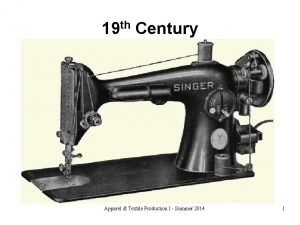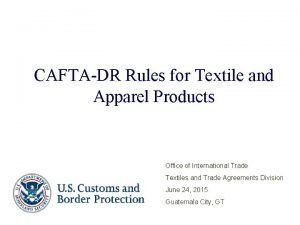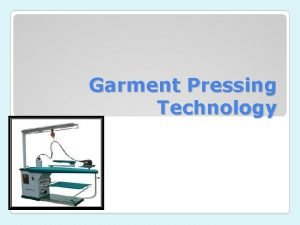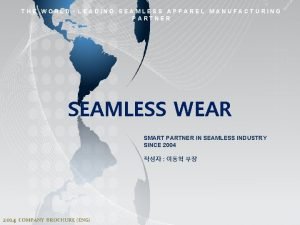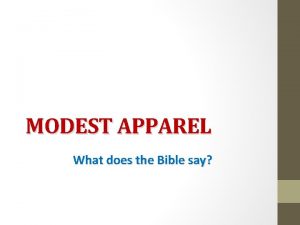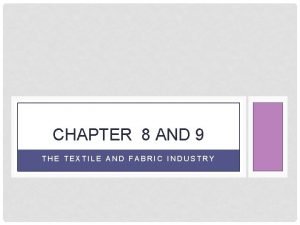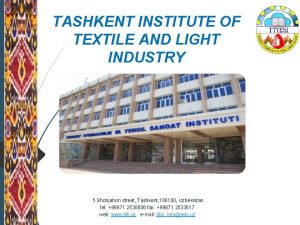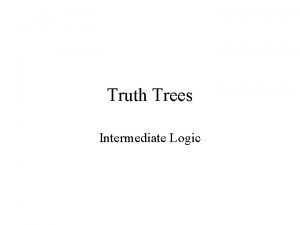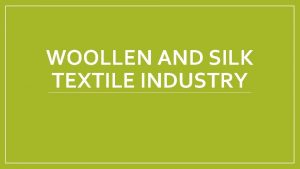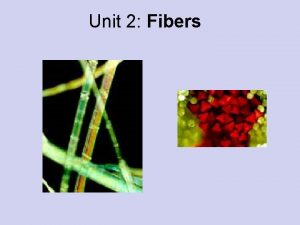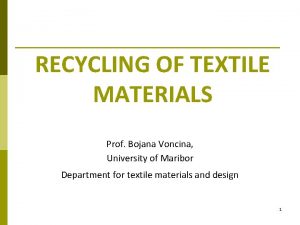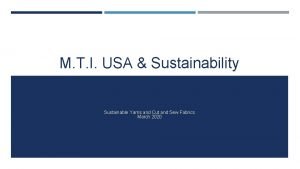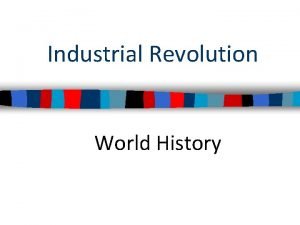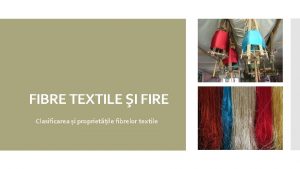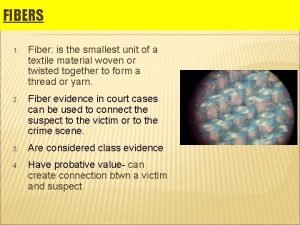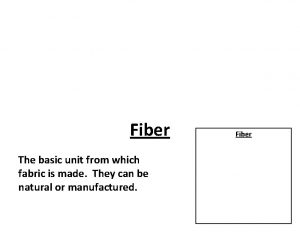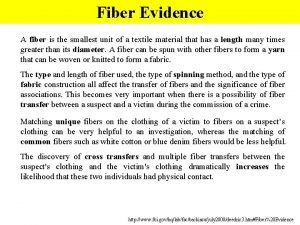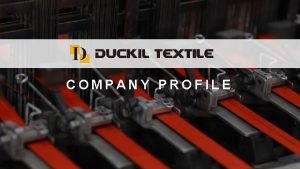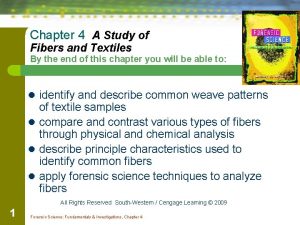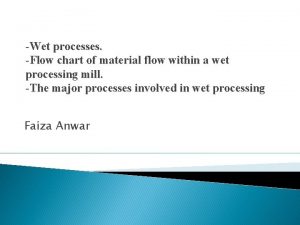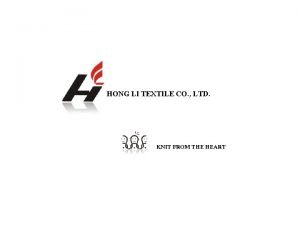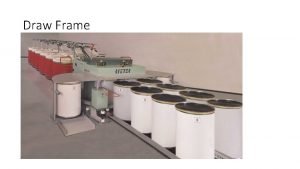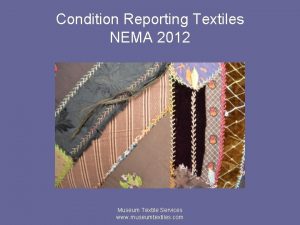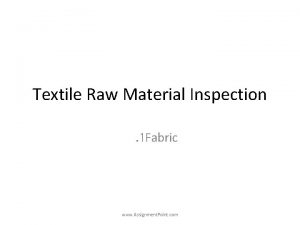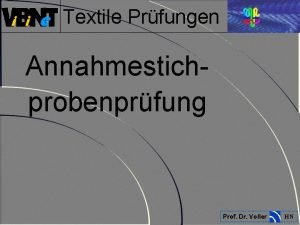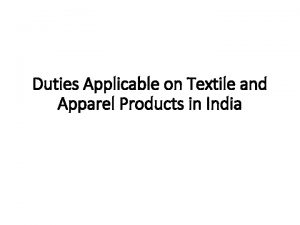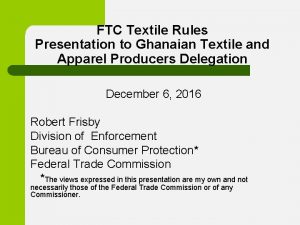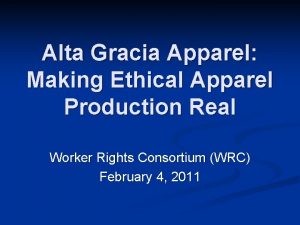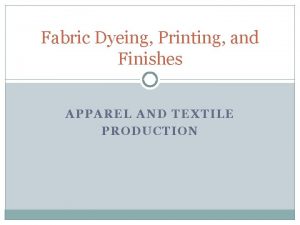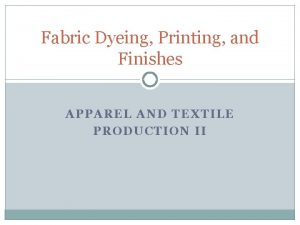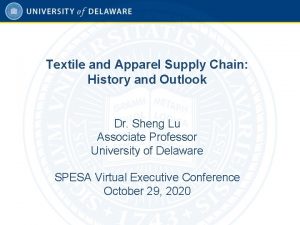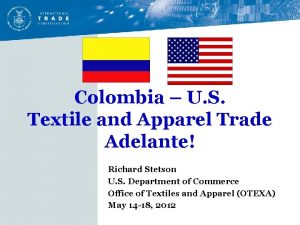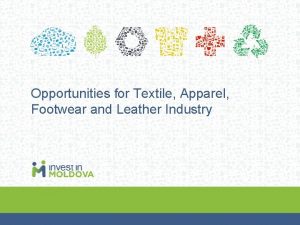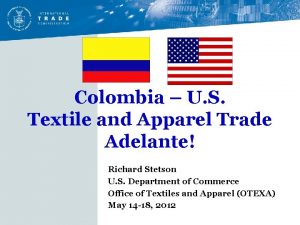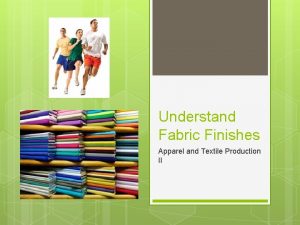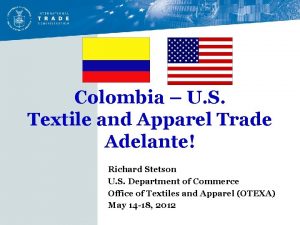CAFTADR Rules for Textile and Apparel Products Office




















































































































- Slides: 116

CAFTA-DR Rules for Textile and Apparel Products Office of International Trade Textiles and Trade Agreements Division June 24, 2015 Guatemala City, GT

Enforcement of CAFTA-DR Rules for Textile and Apparel Products Textiles & Trade Agreements Division Craig Clark, Director Anita Harris, Chief, Textile Policy and Enforcement Jacqueline Sprungle, Program Manager, Textile Enforcement Diane Liberta, International Trade Specialist Jennelle Cray, International Trade Specialist Valetta Lacy, International Trade Specialist

Why Textiles are Important • More than $119 billion in import value • Accounts for 40 percent of all duties collected by CBP • Key Industry for the United States • Highly regulated and legislated • Key industry for trade preference programs • Key industry for Congressional Interest and Legislation

Textiles and Apparel vs. All Imports

The Role of CBP • Designated Textiles as a Priority Trade Issue (PTI) • Determines the policy for the implementation and enforcement of laws affecting the textile industry • Ensures effective enforcement of the tariff and trade laws including the compliant use of trade programs • Provides technical assistance to the Office of the United States Trade Representative 5

Textile Enforcement Focus • Origin fraud / illegal transshipment • Enforcement of free trade agreements and legislated programs • Invalid Importers of Record: right to make entry issues / non-existent importers / shell companies / identity theft • Duty circumvention through misdescription, underrreporting, and undervaluation • Smuggling 6

Textile Enforcement Tools • Textile production verification teams • Special operations • Field taskings • Training of CBP trade personnel • Collaboration with ICE Homeland Security Investigations • Collaboration with stakeholders • Collaboration with foreign counterparts • Audits • Laboratory and Scientific Services 7

Textile/Apparel Supplier Countries by Value FY 13 FY 14

Textile & Apparel Trade Preference Activity 9

U. S. Textile/Apparel Imports from CAFTA -DR Partners Source: U. S. Customs and Border Protection, Fiscal Year 2014 by Quantity by Value Million SME % Claiming Preference 1, 087. 0 95% 2, 649. 2 91% El Salvador 813. 8 93% 1, 961. 3 94% Nicaragua 459. 9 77% 1, 487. 2 79% Guatemala 355. 4 60% 1, 370. 0 70% Dominican Republic 272. 6 94% 851. 0 88% 45. 6 77% 96. 0 82% Country Honduras Costa Rica Million US$ % Claiming Preference 10

Understanding CAFTA-DR Rules for Textile and Apparel Products 11

Understanding CAFTA-DR Rules for Textile and Apparel Products § U. S. legal concepts of “Shared Responsibility, ” “Informed Compliance, ” and “Reasonable Care” apply to importers § By making a claim for preferential treatment under CAFTA-DR, the Importer of Record is declaring to CBP they know, understand meet the preference rule § No special documents are needed for entry purposes § Importer of Record must substantiate the claim is valid 12

Official Resources to Help Understand Textile CAFTA-DR Rules § Harmonized Tariff Schedule of the United States (HTS) § U. S. Code of Federal Regulations (CFR) § CAFTA-DR Commercial Availability (Short Supply) List § U. S. Customs and Border Protection Resources: § Customs Rulings Online Search System (CROSS) § Informed Compliance Publications § TBTs and QBTs § U. S. Trade Data: § Office of Textiles and Apparel (OTEXA), U. S. Department of Commerce § U. S. International Trade Commission (USITC) Data. Web 13

Official Resources (U. S. Government) Harmonized Tariff Schedule of the United States (HTS) – GN 29 14

Official Resources (U. S. Government) CAFTA-DR Commercial Availability (Short Supply) List § Office of Textiles and Apparel (OTEXA), U. S. Department of Commerce § http: //otexa. ita. doc. gov 15

Official Resources (U. S. Government) U. S. Customs and Border Protection Resources – TBTs, QBTs § Textile Bulletin Transmittals (TBTs) § (Example) TBT-07 -019 Documents Used to Verify Free Trade Agreements and Legislated Trade Program Claims for Textiles and Wearing Apparel § http: //www. cbp. gov/trade/priority-issues/textile-booktransmittals-tbts § Quota Bulletin Transmittals (QBTs) § (Example) QBT-09 -102 CAFTA-DR MX Cumulation (Announcement of Quota Limit for 2010) § http: //www. cbp. gov/trade/quota/bulletins 16

Ways to Qualify for CAFTA-DR Preference § CAFTA-DR “Originating” Goods § Wholly Obtained or Produced § Produced Exclusively from Originating Materials § Product-Specific Tariff Shift Rules § “Cut and Sew” Garments § Commercial Availability or “Short Supply” § Cumulation (Using Materials from Mexico) § Folklore § Special Treatment for Certain Non-Originating Goods § Tariff Preference Levels (TPLs) 17

Textile and Apparel Qualifying Imports U. S. Imports from CAFTA-DR countries Source: Customs and Border Protection, FY 2014, by Value 18

CAFTA-DR Import Requirements CAFTA-DR Transit and Transshipment HTS GN 29 (c); 19 CFR 10. 604 § CAFTA-DR Originating Goods Entering the United States Must Be Imported Directly from a CAFTA-DR Partner Country § Production Outside CAFTA-DR Territory Not Allowed § Goods Must Remain Under Control of Customs Authorities in Non-Parties 19

CAFTA-DR Entry Indicators HTS GN 29 (a) § Goods for which Preferential Treatment is Claimed as Originating Goods Under the Terms of CAFTA-DR, Enter United States Under a Provision: § in Chapters 1 through 97 with a Special Program Indicator (SPI) of “P” or § in Chapter 98 or 99 of the HTS (CAFTA-DR) 20

CAFTA-DR “Originating” Goods Textile and Apparel Goods HTS GN 29 (b), (c), (d), (m) and (n) § Textile and Apparel Goods May Be Originating Under CAFTA-DR by Meeting One of Six Rules: § Wholly Obtained or Produced § Produced Exclusively from Originating Materials § Tariff Shift Rules § Including “Cut & Sew” garments § Commercial Availability (Short Supply) § Cumulation § Folklore* (prospective) 21

CAFTA-DR Tariff Shift HTS GN 29 (n) § CAFTA-DR Tariff Shift Rules are the Preference Rule Used Most Often for Originating Textile and Apparel Goods § Product Specific Tariff Shift Rule Listed in HTS GN 29 (n) § Generally, the Following Concepts* Apply: § Fiber-forward: Yarn, Knit Fabric § Yarn-forward: Woven Fabric, Apparel (Other than Wool), Made-Up Articles § Fabric-forward: Wool Apparel § “Cut and Sew”: Certain Apparel Articles * Be Careful – the “Concept” is NOT the Rule 22

CAFTA-DR Tariff Shift HTS GN 29 (n) § Tariff Shift Rules Rely on the Basic Classification Structure of the HTS § Understanding a Specific Tariff Shift Rule Requires Knowing the HTS Classification of the Finished Good AND the HTS Classification of the Materials Used to Produce the Good § Correct Classification is Critical! § Helpful Resources: § HTS § Informed Compliance Publications § Customs Rulings Online Search System (CROSS) (Past Rulings) or § Submit a Request for a Ruling (also referred to as “Advance” or “Binding” Ruling) 23

Tariff Shift Groupings HTS Headings for Fibers, Yarns and Fabrics Fibers Yarns Fabrics 5001 -5003: Silk 5004 -5006: Silk 5007: Silk 5101 -5105: Wool 5106 -5110: Wool 5111 -5113: Wool (Woven) 5201 -5203: Cotton 5204 -5207: Cotton 5208 -5212: Cotton (Woven) 5301 -5305: Vegetable 5306 -5308: Vegetable Fibers 5309 -5311: Vegetable Fibers (Woven) 5501 -5507: Man-made Staple 5401 -5406: Man-made Filament 5407 -5408: Man-made Filament (Woven) 5508 -5511: Man-made Staple 5512 -5516: Man-made Staple (Woven) 5604 -5606: Specialty 5602 -5603: Felt & Non-Woven (Rubber, Coated, Metal, etc) 5801 -5804: Specialty 5901 -5911: Coated 6001 -6006: Knit Fabrics 24

CAFTA-DR Tariff Shift Example – Girls’ Knit Dress Classification – HTS Chapter 61 25

CAFTA-DR Tariff Shift Example – Girls’ Knit Dress HTS GN 29 (n) § Girls’ Knit Wool Dress HTS 6104. 41. 0020 § Girls’ Knit Cotton Dress HTS 6104. 42. 0020 § CAFTA-DR Tariff Shift Rule from GN 29 (n) Chapter 61 No. 20 (Same for Both): 26

CAFTA-DR Tariff Shift Example – Girls’ Knit Dress HTS GN 29 (n) § A change to subheadings 6104. 41 through 6104. 49 [6104. 41. 0020 or 6104. 42. 0020] from any other chapter, except from headings 5111 through 5113 [Wool Woven Fabric], 5204 through 5212 [Cotton Yarn or Woven Fabric], 5310 through 5311 [Woven Vegetable Fiber Fabric], chapter 54 [Man-made Filament Yarn or Woven Fabric], headings 5508 through 5516 [Man-made Staple Yarn or Woven Fabric] or 6001 through 6006 [Knit Fabric], provided that the good is cut or knit to shape, or both, and sewn or otherwise assembled in the territory of one or more of the parties to the Agreement. 27

CAFTA-DR Tariff Shift Example – Girls’ Knit Dress HTS GN 29 (n) § “Except from” is the phrase that tells us which materials used in the production of the finished good must also be CAFTA-DR originating § Materials classified in excluded tariff provisions – by chapter (2 digits), by heading (4 digits) or by subheading (6 digits) of the tariff schedule – are required to be CAFTA-DR originating in order for the good produced from those materials to be eligible for CAFTA-DR treatment 28

CAFTA-DR Tariff Shift Example – Girls’ Knit Dress HTS GN 29 (n) § Girls’ Cotton Knit Dress–Knit Cotton Fabric AND Cotton Yarn Must Be CAFTA-DR Originating § Tariff Shift Rule Follows “Yarn-forward” Concept § “Except from” Cotton Yarn (subheading 5204 to 5207) AND Cotton Knit Fabric (subheading 6001 to 6007) § Girls’ Wool Knit Dress–Knit Wool Fabric Must Be CAFTA-DR Originating § Tariff Shift Rule Follows “Fabric-forward” Concept § “Except from” Wool Knit Fabric (subheading 6001 to 6007) Only § Wool Yarn (subheading 5106 to 5110) Not Listed After “Except from” Clause § If a Cotton/Wool Blend Knit Fabric: Knit Fabric AND Cotton Yarn Must Be CAFTA-DR Originating, But Wool Yarn Not Required To Be CAFTA-DR 29

CAFTA-DR Tariff Shift Example – Girls’ Woven Silk Dress HTS GN 29 (n) § Girls’ Woven Silk Dress HTS 6204. 49. 1000 § CAFTA-DR Tariff Shift Rule from GN 29 (n) Chapter 62 No. 25: § Silk Woven Fabric Classified Under HTS Subheading 5007 § Not Listed After the “Except From” Clause § Therefore, Silk Woven Fabric Not Required to be CAFTA-DR Originating § Tariff Shift Rule is Example of a “Cut and Sew” Concept 30

CAFTA-DR Tariff Shift Chapter Rules for Goods in Chapters 61, 62 and 63 HTS GN 29 (n) § Tariff Classification Component – Chapters 61, 62 and 63 § Visible Lining Fabric – Chapters 61 and 62 § Narrow Elastic Fabric – Chapters 61 and 62 § Sewing Thread – Chapters 61, 62 and 63 § Pocket Bag Fabric – Chapters 61 and 62 § “Chapter Rules” Apply In Addition to the CAFTA-DR Tariff Shift Rule for Goods Classified in Chapters 61, 62 and 63 31

CAFTA-DR Tariff Shift Chapter Rules for Goods in Chapters 61, 62 and 63 HTS GN 29 (n) § Since October 13, 2012, Chapter Rule Requirements May be Satisfied by Using Visible Lining Fabric, Narrow Elastic Fabric, Sewing Thread or Pocket Bag Fabric if Such Materials Are Included on the Short Supply List * * Second CAFTA-DR Textile Amendments, Effective 10/13/2012 32

CAFTA-DR Tariff Shift Chapter Rules for Goods in Chapters 61, 62 and 63 GN 29 (n) Tariff Classification Component: Chapter 61 Rule 2, Chapter 62 Rule 2, Chapter 63 Rule 1 § Tariff Classification Component Chapter Rule States “Only the Component of the Good That Determines the Tariff Classification of the Good” Must Meet the Specified Tariff Shift Rule 33

CAFTA-DR Tariff Shift Chapter Rules for Goods in Chapters 61, 62 and 63 GN 29 (n) Visible Lining Fabrics: Chapter 61 Rule 1, Chapter 62 Rule 1 § Visible Lining Fabrics Chapter Rule States Select Fabrics, When Used as Visible Lining Material in Certain Garments, Must Be Formed from Yarn and Finished in a CAFTA-DR Country 34

CAFTA-DR Tariff Shift Chapter Rules for Goods in Chapters 61, 62 and 63 GN 29 (n) Visible Lining Fabrics: Chapter 61 Rule 1, Chapter 62 Rule 1 § Visible Lining Fabrics Chapter Rule Only Applies “to the visible lining fabric in the main body of the garment, excluding sleeves, which covers the largest surface area, and shall not apply to removable linings” (See Tariff Classification Component Rule) § When Required to Comply with the Visible Lining Fabrics Chapter Rule, the Tariff Shift Rule Includes a Reminder: 35

CAFTA-DR Tariff Shift Chapter Rules for Goods in Chapters 61, 62 and 63 GN 29 (n) Narrow Elastic Fabrics: Chapter 61 Rule 3, Chapter 62 Rule 3 § Narrow Elastic Fabrics Chapter Rule States “Fabrics of Subheading 5806. 20 or Heading 6002” Contained in Apparel Goods (Chapter 61 or 62) Must Be Formed from Yarn and Finished in a CAFTA-DR Country § Fabrics Classified in Subheading 5806. 20 are Certain Woven Fabrics of a Width Not Exceeding 30 cm, Containing by Weight 5 Percent or More of Elastomeric Yarn or Rubber Thread: § Provided with Selvages (Woven, Gummed or Otherwise) on Both Edges; or § Tubular (Flattened Width Not Exceeding 30 cm); or § Bias Binding with Folded Edges (Unfolded Width Not Exceeding 30 cm) § Fabrics Classified in Heading 6002 are Certain Knitted or Crocheted Fabrics of Width Not Exceeding 30 cm, Containing by Weight 5 Percent or More of Elastomeric Yarn or Rubber Thread 36

CAFTA-DR Tariff Shift Chapter Rules for Goods in Chapters 61, 62 and 63 GN 29 (n) Sewing Thread: Chapter 61 Rule 4, Chapter 62 Rule 4, Chapter 63 Rule 2 § Sewing Thread Chapter Rule States Sewing Thread of Heading 5204, 5401, 5508, or Yarn of Heading 5402 Used as Sewing Thread * Contained in the Good Must Be Formed and Finished in a CAFTA-DR Country § By Definition, Headings 5204 (Cotton), 5401 (Man-made Filament) and 5508 (Manmade Staple) are Multi-Ply or Cabled Yarns or Thread § Since October 13, 2012, Yarn of heading 5402, Single-Ply Yarns Used as Sewing Thread, must be Formed and Finished in a CAFTA-DR Country. * Second CAFTA-DR Textile Amendments, Effective 10/13/2012 37

CAFTA-DR Tariff Shift Chapter Rules for Goods in Chapters 61, 62 and 63 GN 29 (n) Pocket Bag Fabric: Chapter 61 Rule 5, Chapter 62 Rule 5 § Pocket Bag Fabric Chapter Rule States Pocket Bag Fabric Contained in Apparel Goods Must Be Formed and Finished in a CAFTA-DR Country from Yarn Wholly Formed in a CAFTA-DR Country § Chapter Rule for Pocket Bag Fabric Follows the “Yarn-forward” Concept 38

CAFTA-DR Tariff Shift Special Requirements for Textile and Apparel Goods HTS GN 29 (d) § De Minimis § Elastomeric Yarns § Certain Nylon Filament Yarns § “Special Requirements” Apply In Addition to the CAFTA-DR Tariff Shift Rule for All Textile and Apparel Goods 39

CAFTA-DR Tariff Shift Special Requirements for Textile and Apparel Goods GN 29 (d) De Minimis Provision § De Minimis Allowance Permits Limited Use of Non-CAFTA-DR Originating Fibers or Yarns in the Yarns or Fabrics Used in the Production of the Tariff Classification Component of a Textile or Apparel Good § Non-CAFTA-DR Originating Fibers or Yarns May Be Up to 10 Percent of the Total Weight of the Tariff Classification Component 40

CAFTA-DR Tariff Shift Special Requirements for Textile and Apparel Goods GN 29 (d) Elastomeric Yarns § Despite the De Minimis Allowance, Elastomeric Yarns in the Tariff Classification Component Must Always Be Wholly Formed in a CAFTA-DR Country 41

CAFTA-DR Tariff Shift Special Requirements for Textile and Apparel Goods GN 29 (d) Certain Nylon Filament Yarns § De Minimis Allowance Does Not Limit the Quantity of Certain Nylon Filament Yarns (in Specific Subheadings) from Israel, Canada or Mexico (Each a Party to a Free Trade Agreement with the U. S. Prior to January 1, 1995) 42

CAFTA-DR Tariff Shift “Cut and Sew” Garments HTS GN 29 (n) § Tariff Shift Rules for Certain Garments in Chapter 61 and 62 Do Not Include “Except From” Clause § Do Not Follow “Yarn-forward” or “Fabric-forward” Concept § But Incorrect to Call Such Garments Exceptions to the CAFTA-DR Rules § Tariff Shift Rule for a “Cut and Sew” or “Single Transformation” Garment Requires “a Change to Subheading x [of the Specific Garment] from Any Other Chapter, Provided that the Good is Cut or Knit to Shape, or Both, and Sewn or Otherwise Assembled in the Territory of One or More of the Parties to the Agreement. ” 43

CAFTA-DR Tariff Shift “Cut and Sew” Garments HTS GN 29 (n) § Example of a “Cut and Sew” CAFTA-DR Tariff Shift Rule § Women’s Cotton Brassiere Containing Lace HTS 6212. 10. 5010 § CAFTA-DR Tariff Shift Rule from GN 29 (n) Chapter 62 No. 39: 44

CAFTA-DR Tariff Shift “Cut and Sew” Garments HTS GN 29 (n) § Be Careful! Not All “Cut and Sew” CAFTA-DR Tariff Shift Rules Are So Simple § Men’s Woven Cotton Yarn-Dyed Dress Shirt § Classification HTS 6205. 2016 § CAFTA-DR Tariff Shift Rule from GN 29 (n) Chapter 62 No. 30 A: 45

CAFTA-DR Tariff Shift “Cut and Sew” Garments HTS GN 29 (n) § Men’s Woven Cotton Yarn-Dyed Dress Shirt – NOT “Cut and Sew” § Classification HTS 6205. 2016 § CAFTA-DR Tariff Shift Rule from GN 29 (n) Chapter 62 No. 30 B: § This Tariff Shift Rule Follows “Yarn-forward” Concept 46

CAFTA-DR Tariff Shift “Cut and Sew” Garments HTS GN 29 (n) § Exempt from GN 29 (n) Chapter Rules § “Other Than” Clause Contained in Each Chapter Rule States Rule Does Not Apply to “Cut and Sew” Garments § Example of Women’s Brassiere in HTS 6212. 10. 5010 47

CAFTA-DR Tariff Shift “Cut and Sew” Garments HTS GN 29 (n) § Example of a “Cut and Sew” CAFTA-DR Tariff Shift Rule Since October 13, 2012, This Type of Tariff Shift Rule Also Applies to Certain Women’s Woven Pajama Bottoms, in Addition to the Other Garments Already Eligible for “Cut and Sew” Rules. * Second CAFTA-DR Textile Amendments, Effective 10/13/2012 48

CAFTA-DR Tariff Shift HTS GN 29 (n) § Filing a CAFTA-DR Claim Based on Tariff Shift Rules: § Use 10 -Digit HTS Number from Chapter 1 -97 in First Tariff Field of the U. S. Entry Summary § Affix Special Program Indicator of “P” in Front of First Tariff Field 49

CAFTA-DR Commercial Availability (Short Supply) HTS GN 29 (m)(viii), Chapter 98 Subchapter XXII, Note 20 § Commercial Availability or “Short Supply” Fibers, Yarns and Fabrics Listed in HTS Chapter 98 Subchapter XXII, Note 20 § Items No. 1 to 70 Only § Additions to CAFTA-DR Short Supply List Only on OTEXA Website: § http: //otexa. ita. doc. gov: CAFTA-DR Commercial Availability § +140 Items on List 50

CAFTA-DR Commercial Availability (Short Supply) HTS GN 29 (m)(viii), Chapter 98 Subchapter XXII, Note 20 § CAFTA-DR Preference Rule for Short Supply Defined GN 29 (m)(viii): § Textile Goods of Chapters 50 through 60 Must Be Wholly Formed in a CAFTA-DR Country From…: One or More of the Fibers, Yarns or Fabrics on the CAFTA-DR Commercial Availability (Short Supply) List, or Originating Fibers, Yarns or Fabrics, or a Combination of Both 51

CAFTA-DR Commercial Availability (Short Supply) HTS GN 29 (m)(viii), Chapter 98 Subchapter XXII, Note 20 § CAFTA-DR Preference Rule for Short Supply Defined GN 29 (m)(viii): § Apparel Goods of Chapters 61 or 62 Must Be Cut or Knit to Shape, or Both, and Sewn or Otherwise Assembled in a CAFTA-DR Country, and the Fabric of the Outer Shell, Exclusive of Collars and Cuffs and Ribbed Waistbands (Only if the Ribbed Waistband is Present in Combination with Cuffs and Identical in Fabric Construction to the Cuffs*) Where Applicable Must Be From…: One or More of the Fibers, Yarns or Fabrics on the CAFTA-DR Commercial Availability (Short Supply) List, or Originating Fibers, Yarns or Fabrics, or a Combination of Both * Second CAFTA-DR Textile Amendments, Effective 10/13/2012 52

CAFTA-DR Commercial Availability (Short Supply) HTS GN 29 (m)(viii), Chapter 98 Subchapter XXII, Note 20 § CAFTA-DR Preference Rule for Short Supply Defined GN 29 (m)(viii): § Textile Goods of Chapter 63 or Subheading 9404. 90 Must Be Cut or Knit to Shape, or Both, and Sewn or Otherwise Assembled in a CAFTA-DR Country, and the Component That Determines the Tariff Classification of the Good Must Be From…: One or More of the Fibers, Yarns or Fabrics on the CAFTA-DR Commercial Availability (Short Supply) List, or Originating Fibers, Yarns or Fabrics, or a Combination of Both 53

CAFTA-DR Commercial Availability (Short Supply) HTS GN 29 (m)(viii), Chapter 98 Subchapter XXII, Note 20 § Be Careful: CAFTA-DR Short Supply Materials Must Meet All Specifications Such as Fiber Content, Width, Thread Count, Finishing Operations, Etc… Classification Alone Not Enough 54

CAFTA-DR Commercial Availability (Short Supply) HTS GN 29 (m)(viii), Chapter 98 Subchapter XXII, Note 20 § GN 29 (n) Tariff Shift Rules, Including the CAFTA-DR Chapter Rules for Goods in Chapters 61, 62 and 63, Do Not Apply When Using CAFTA-DR Short Supply Rules § If the component that determines classification is made of a short supply product, the chapter rules do not apply and items such as pocket bags, visible linings, etc. do not have to come from a party to the agreement § CAFTA-DR De Minimis Requirements Apply When Using Short Supply Rules § If the component that determines classification is made of a short supply product, up to 10% of the weight of the component may be non-originating 55

CAFTA-DR Commercial Availability (Short Supply) Modification HTS GN 29 (m)(viii), Chapter 98 Subchapter XXII, Note 20 § CAFTA-DR De Minimis Requirement applies to originating yarns and fabrics used in combination with Short Supply Rules § If there is a combination of short supply yarns (or fabrics) and originating yarns (or fabrics), the elastomeric yarns contained in short supply yarns (or fabrics) may be of any origin, while elastomeric yarns in the originating yarns (or fabrics) MUST be formed in a party to the agreement * Second CAFTA-DR Textile Amendments, Effective 10/13/2012 56

CAFTA-DR Commercial Availability (Short Supply) HTS GN 29 (m)(viii), Chapter 98 Subchapter XXII, Note 20 § Filing a CAFTA-DR Short Supply Claim § Use HTS 9822. 05. 01 in First Tariff Field of the U. S. Entry Summary § Use 10 -Digit HTS Number from Chapter 50 through 63 or Subheading 9404. 90 in Second Tariff Field § Affix Special Program Indicator of “P” in Front of Second Tariff Field § Report Value and Quantity of the Goods with Second Tariff Field 57

Modifications to the CAFTA-DR Short Supply List § All additions or removals from the short supply list are handled by the Committee for the Implementation of Textile Agreements (CITA) at the U. S. Department of Commerce § Parties may make a Commercial Availability Request to have an item added to the list or a Request to Remove or Restrict to have an item removed from the list § Parties must substantiate requests with evidence provided to CITA for review § CITA will post any accepted requests on its website for public notice 58

CAFTA-DR Cumulation HTS GN 29 (d)(vii); Chapter 98 Subchapter XXII, Note 21; Subject to Limit(s) § Cumulation Permits the Use of Materials from Mexico In Place of CAFTA-DR Originating Materials for Goods of Chapter 62 § GN 29 (n) Tariff Shift Rules Including CAFTA-DR Chapter Rules for Chapter 62 Apply to Cumulation Goods § Limited to 100 Million SME Annually With Sublimits for (a) Cotton (Other Than Blue Denim) and Man-made Fiber Skirts and Trousers; (b) Blue Denim Trousers and Blue Denim Skirts; and (c) Wool Garments § Product Coverage for Each Limit Listed in Chapter 98 Subchapter XXII Note 21 § Certain Wool Garments Exempt from Limit and Chapter 62 Rules 59

CAFTA-DR Cumulation HTS GN 29 (d)(vii); Chapter 98 Subchapter XXII, Note 21; Subject to Limit(s) § Filing a CAFTA-DR Cumulation Claim § Use HTS 9822. 05. 11* in First Tariff Field of the U. S. Entry Summary § Use 10 -Digit Chapter 62 HTS Number in Second Tariff Field § Affix Special Program Indicator of “P” in Front of Second Tariff Field § Report Value and Quantity of the Goods with Second Tariff Field § Require a Quota-Type Entry Code * Wool Garments Exempt from Limit Use HTS 9822. 05. 13 60

CAFTA-DR Folklore * HTS Chapter 98 Subchapter XXII Note 26 * Prospective U. S. Committee for the Implementation of Textile Agreements (CITA) and CBP Will Provide More Information on CAFTA-DR Folklore Requirements For Any Future CAFTA-DR Folklore Agreements 61

CAFTA-DR Sets HTS GN 29 (c)(v) § Textile or Apparel Good Classifiable as Goods Put Up for Retail Sale as Provided Under General Rule of Interpretation (GRI) 3 to the HTS is Eligible for CAFTA-DR Treatment If: § Each of the Goods in the Set is an Originating Good § Total Value of the Non-Originating Goods in the Set Does Not Exceed 10 Percent of the Adjusted Value of the Set § Be Careful: Very Few Textile or Apparel Articles Can Be Properly Classified as GRI 3 Sets. See CBP Informed Compliance Publication on “Sets” for More Information. 62

CAFTA-DR Review of the Rules Review - Textile and Apparel Goods HTS GN 29 (b), (c), (d), (m) and (n) Tariff Shift Rules, Short Supply, Cumulation - True or False? § All originating goods must be shipped directly to the U. S. from a CAFTADR country and may not undergo additional processing outside of the CAFTA-DR Parties. § Only the Importer of Record may request a ruling from CBP. § The Special Program Indicator for CAFTA-DR is “Q. ” 63

CAFTA-DR Review of the Rules Review - Textile and Apparel Goods HTS GN 29 (b), (c), (d), (m) and (n) Tariff Shift Rules, Short Supply, Cumulation - True or False? § The CAFTA-DR Chapter Rules (Tariff Classification Component, Visible Linings, Narrow Elastic Fabrics, Sewing Thread, Pocket Bag Fabrics) are applied with: § All Tariff Shift Rules for Goods in Chapters 61, 62 and 63 § Most Tariff Shift Rules with Some Exceptions § Short Supply Rules for Apparel § Cumulation Rule for Garments in Chapter 62 64

CAFTA-DR Review of the Rules Review - Textile and Apparel Goods HTS GN 29 (b), (c), (d), (m) and (n) Tariff Shift Rules, Short Supply, Cumulation - True or False? § For all three rules above, apparel goods must always be “cut, or knit-to -shape, or sewn or otherwise assembled” in a CAFTA-DR country. § A CAFTA-DR short supply knit polo shirt may use collars and cuffs pre -formed and cut in Korea. § A CAFTA-DR cumulation claim may be filed for a T-shirt knit-to-shape and assembled in Guatemala from Mexican cotton yarn. § Making a CAFTA-DR claim always requires the use of two tariff fields on the U. S. Entry Summary (CBP Form 7501). 65

CAFTA-DR Review of the Rules Women’s Woven Trousers, Blue Denim, HTS 6204. 62. 40. 11 HTS GN 29 (b), (c), (d), (m) and (n) – Tariff Shift? Short Supply? Cumulation? § Cut and Sewn in Honduras § Blue Denim Fabric HTS 5209 formed and finished in U. S. § Fabric Made from Cotton Yarns HTS 5205 formed and finished in U. S. § What if Blended with Elastomeric Yarns? § Sewing Thread 5204 formed and finished in Costa Rica § Pocket Bag Fabric formed from U. S. Yarns in Mexico § Rivets and Zipper from China § Embroidered with Cotton (Single-Ply) Yarns HTS 5205 from Korea § What if Cotton Multi-ply Yarns HTS 5204? 66

CAFTA-DR Non-Originating Goods Special Treatment for Certain Non-Originating Goods § Reduced Duty Provisions: § Duty Assessed on Value-Added Only Provision § Reduced Rate of Duty for Certain Woven Garments § Earned Import Allowance Program § Also Known As the 2 -for-1 Program for the Dominican Republic § Do Not Use Special Program Indicator (SPI) of “P” § Subject to Merchandise Processing Fee (MPF) § Only “Originating” Goods are Exempt from MPF 67

Special Treatment for Certain Non-Originating Goods Duty Assessed on Value-Added Only HTS GN 29 (d)(iv); Chapter 98 Subchapter XXII Note 22 § Non-CAFTA-DR-Originating Textile or Apparel Goods Classified in Chapters 61, 62 or 63 Qualify If: § Good is Cut and Sewn or Otherwise Assembled in CAFTA-DR Country from: § Fabrics Wholly Formed in the United States (or Components Knit to Shape in the United States) § Assembled with Thread Wholly Formed in the United States § Column One Rate of Duty Assessed on “Value of the Assembled Good Minus the Value of the Fabrics Formed in the United States, Components Knit to Shape in the United States and Any Other Materials of U. S. Origin Used in the Production” of the Good 68

Special Treatment for Certain Non-Originating Goods Duty Assessed on Value-Added Only HTS GN 29 (d)(iv); Chapter 98 Subchapter XXII Note 22 § Filing a CAFTA-DR Value-Added Reduced Duty Claim § Use HTS 9822. 05. 10 in First Tariff Field of the U. S. Entry Summary § Use 10 -Digit Chapter 61, 62 or 63 HTS Number in Second Tariff Field § NO Special Program Indictor (SPI) § Report Value of U. S. Materials with First Tariff Field § Report Quantity and Full Value of the Goods Minus the Value of the U. S. Materials with Second Tariff Field 69

Special Treatment for Certain Non-Originating Goods Reduced Rate of Duty for Certain Woven Garments Chapter 98 Subchapter XXII HTS 9822. 05. 30 through 9822. 05. 70 § Specific Non-CAFTA-DR-Originating Apparel Goods Classified in Chapter 62 Qualify If: § Good is Cut and Sewn or Otherwise Assembled in CAFTA-DR Country § Satisfy CAFTA-DR Chapter 62 Rules of GN 29 (n) § Assessed Rate of Duty is Column One Rate Minus 0. 5 Percent or Column One Rate Minus 2. 0 Percent Depending on Garment’s Classification (For Example, Duty Rate of 16% Becomes 15. 5% or 14%) 70

Special Treatment for Certain Non-Originating Goods Reduced Rate of Duty for Certain Woven Garments Chapter 98 Subchapter XXII HTS 9822. 05. 30 through 9822. 05. 70 71

Special Treatment for Certain Non-Originating Goods Reduced Rate of Duty for Certain Woven Garments Chapter 98 Subchapter XXII HTS 9822. 05. 30 through 9822. 05. 70 § Filing a CAFTA-DR Reduced Rate of Duty Claim § Use HTS 9822. 05. 30 through 9822. 05. 70 in First Tariff Field of the U. S. Entry Summary § Use 10 -Digit Chapter 62 HTS Number in Second Tariff Field § NO Special Program Indictor (SPI) § Report Full Value and Quantity with Second Tariff Field 72

Special Treatment for Certain Non-Originating Goods Earned Import Allowance Program (2 -for-1 for Dominican Republic) Chapter 98 Subchapter XXII Note 27 § Duty-Free Treatment for Certain Woven Apparel Articles Provided the Garments are Wholly Assembled in the Dominican Republic “Without Regard to the Source of the Fabric or Yarns from which the Articles are Made” § Trousers, Bib and Brace Overalls, Breeches and Shorts, Skirts and Divided Skirts and Pants of Cotton (But Not Denim) § Satisfy CAFTA-DR Chapter 62 Rules of GN 29 (n) § Administered and Managed by OTEXA § Requires OTEXA-Issued Certificate to Utilize “Credits” for Previous Use of U. S. Fabrics from U. S. Yarns § See OTEXA Website for Additional Information and Registration: http: //otexa. ita. doc. gov 73

Special Treatment for Certain Non-Originating Goods Earned Import Allowance Program (2 -for-1 for Dominican Republic) Chapter 98 Subchapter XXII Note 27 § Filing a Earned Import Allowance Claim § Use HTS 9822. 06. 05 in First Tariff Field of the U. S. Entry Summary § Use 10 -Digit Chapter 62 HTS Number in Second Tariff Field § NO Special Program Indictor (SPI) § Report Value and Quantity with Second Tariff Field § OTEXA-Issued Certificate Number Must Also Be Reported § Certificate Must Be Available to CBP Upon Request 74

CAFTA-DR Tariff Preference Levels – Chapter 99 Subchapter XV § Costa Rica: § Certain Wool Woven Garments (Two TPLs) § Specialty Women’s Swimwear § Nicaragua § Cotton or Man-made Fiber Apparel, or Subject to Cotton or Man-made Fiber Restraints, Plus Certain Men’s Wool Sports Coats § Do Not Use Special Program Indicator (SPI) of “P” § Subject to Merchandise Processing Fee (MPF) § Only “Originating” Goods are Exempt from MPF 75

CAFTA-DR Tariff Preference Levels Costa Rica § Tailored Woven Apparel of Wool, or Subject to Wool Restraints § Chapter 99 Subchapter XV Note 16 (a) and (b) § HTS 9915. 62. 05 § HTS GN 29 (n) Chapter 62 Rules Apply § Tailored Woven Apparel of Certain Wool Fabrics § Chapter 99 Subchapter XV Note 16 (c) and (d) § HTS 9915. 62. 15 § Women’s Specialty Swimwear § Chapter 99 Subchapter XV Note 17 § HTS 9915. 61. 03 or 9915. 61. 04 76

CAFTA-DR Tariff Preference Levels Costa Rica § Garments Must Be Cut or Knit to Shape, or Both, and Sewn or Otherwise Assembled in Costa Rica § Filing a CAFTA-DR Costa Rica TPL Claim: § Use Chapter 99 HTS Number for TPL (Above) in First Tariff Field § Use 10 -Digit Chapter 62 HTS Number in Second Tariff Field § NO Special Program Indicator (SPI) § Report Value and Quantity of Goods with Second Tariff Field 77

CAFTA-DR Tariff Preference Levels Nicaragua § Apparel Classified in Chapters 61 or 62 of the HTS, of Cotton or Man-made Fibers, or Subject to Cotton or Man-made Fiber Restraints; and Men’s Sports’ Coats of Carded Wool Fabric (Sublimit) § Chapter 99 Subchapter XV Note 15 § HTS 9915. 61. 01 § Certificate of Eligibility Issued by Government of Nicaragua Required at Entry 78

CAFTA-DR Tariff Preference Levels Nicaragua § Garments Must Be Cut or Knit to Shape, or Both, and Sewn or Otherwise Assembled in Nicaragua § CBP Rule NYM 84389 Confirms Apparel “Cut or Knit to Shape, or Both, and Sewn or Otherwise Assembled” in Nicaragua Which is Subject to Post-Assembly Finishing Operations in Another CAFTA-DR Country Remains Eligible for Nicaragua’s CAFTADR TPL. § Filing a CAFTA-DR Nicaragua TPL Claim: § Use HTS 9915. 61. 01 in First Tariff Field § Use 10 -Digit Chapter 61 or 62 HTS Number in Second Tariff Field § NO Special Program Indicator (SPI) § Report Value and Quantity of Goods with Second Tariff Field § Certificate of Eligibility Issued by Government Nicaragua Required at Entry 79

CAFTA-DR “Non-Originating” Goods - Duty Free? Women’s Woven Trousers, Blue Denim, HTS 6204. 62. 40. 11 Value-Added? Reduced Rate of Duty? 2 -for-1 Earned Import Allowance? TPL? § Stone-washed in Guatemala (Post-Assembly) § What if Stone-washed in Mexico? § Cut and Sewn in Nicaragua § Blue Denim Fabric HTS 5209 formed and finished in U. S. § Fabric Made from Cotton Yarns HTS 5205 formed and finished in Taiwan § Sewing Thread 5204 formed and finished in Costa Rica § What if Sewing Thread 5204 formed and finished in the United States? § Pocket Bag Fabric formed from U. S. Yarns in Guatemala § Rivets and Zipper from China § Embroidered with Cotton (Single-Ply) Yarns HTS 5205 from Korea 80

Understanding CAFTA-DR Rules for Textile and Apparel Products § CAFTA-DR Preference Rules for Textile and Apparel Products § CAFTA-DR “Originating” Goods § Wholly Obtained or Produced § Produced Exclusively from Originating Materials § Product-Specific Tariff Shift Rules § “Cut and Sew” Garments § Commercial Availability or “Short Supply” § Cumulation (Using Materials from Mexico) § Folklore § Special Treatment for Certain Non-Originating Goods § Tariff Preference Levels 81

Verifying CAFTA-DR Rules for Textile and Apparel Products 82

Verifying CAFTA-DR Rules for Textile and Apparel Products § Responsibilities § Importers § Manufacturers § How CBP Verifies CAFTA-DR Preference Claims § CBP Port Verifications § Production Verification Factory Visits 83

Responsibilities Importer of Record § U. S. Legal Concepts of “Informed Compliance” and “Shared Responsibility” make Importer of Record Responsible for: § Exercising “Reasonable Care” to Enter, Classify, Properly Mark with Country of Origin, and Accurately Value Imported Merchandise § Providing Any Other Information Necessary to Enable CBP to Properly Assess Duties, Collect Accurate Statistics and Determine Whether Any Other Applicable Legal Requirements are met 84

Documentation Required for Entry 19 CFR 142. 3 (Entry Documentation) and 19 CFR 141. 11 (Right to Make Entry) Documentation Required for Entry (19 CFR 142. 3): §CBP Form 7501 Entry Summary § Right to Make Entry – Negotiable Bill of Lading (19 CFR 141. 11) § Commercial Invoice § Packing List § Other Documentation As Required by Other U. S. Agencies 85

Responsibilities Importer of Record § Non-U. S. Importer of Record Must Have Resident Agent in the United States § To Make a CAFTA-DR Claim, What You Need to Know: § § § Where are the Goods Classified Where does the Fabric Originate Where does the Yarn Originate Where does the Thread Originate Why is the Fabric Short Supply § Familiarity with the CAFTA-DR Rules § Large Potential Duty Liability if Not Eligible for CAFTA-DR § Penalties May Also Apply 86

Responsibilities Manufacturer § Who Purchases Thread, Yarn or Fabric § Cut, Make and Trim (CMT) or Free on Board (FOB) § Commercial Invoice Accurately Reflects Price – Include Cost of Fabric § Sub-Contract the Manufacturing § Manufacturer Buys Fabric – Is the Origin of Yarn Known 87

Responsibilities Manufacturer § Importer Purchases Fabric – Coordinate with Importer to Validate Origin of Yarn and Fabric § Fabric Inventory – Foreign Fabric Must Be Clearly Separated from Originating Fabric § If Asked by CBP, Importer Must Prove or Support Claim for CAFTA-DR Treatment; Failure Will Result in Duties and Possible Penalties § Just Because a Good is Exported from Country X Does Not Mean that X is the Country of Origin 88

Invoice Requirements 19 CFR 141. 86 89

Invoice Requirements 19 CFR 141. 86 § Port of Entry § Name of Importer § Detailed Description of the Merchandise § Quantities § Purchase Price in U. S. Dollars § Country of Origin 90

Responsibilities Review § For CBP, who is legally responsible for the accuracy of entry documents for U. S. imports? § Manufacturer of the goods § Licensed Customs Broker § Importer of Record § Attorney for the Ultimate Consignee (Buyer) § Which of the following is not a required entry document? § CBP Form 7501 Entry Summary § Commercial Invoice § CAFTA-DR Declaration or Importer Certification § Negotiable Bill of Lading 91

Verifying Preference Claims § CBP Port Verifications § Textile Production Verification Teams 92

CBP Port Verifications § Generally Conducted Post Entry Summary § Do Not Require the Detention of Merchandise § Exam and Acquisition of Sample May be Required § CBP Will Request Proof of Origin for Origin-Restricted Inputs, such as: § Affidavit from Actual Producers of Yarn and Fabric § Commercial Invoice Clearly Stating Goods Were Produced by Factory § Other Documents as Required § CBP May Verify Accuracy of Affidavits with Mills § CBP May Request Documents in Support of Transit and Transshipment Requirements 93

Verifying CAFTA-DR Claims Importer Certification (19 CFR 10. 584) & Supporting Documents Sec. 10. 584 Certification. (a) General. An importer who makes a claim under Sec. 10. 583(b) of this subpart based on a certification of the importer, exporter, or producer that the good qualifies as originating must submit, at the request of the port director, a copy of the certification. The certification: (1) Need not be in a prescribed format but must be in writing or must be transmitted electronically pursuant to any electronic means authorized by CBP for that purpose; (2) Must be in the possession of the importer at the time the claim for preferential tariff treatment is made if the certification forms the basis for the claim; 94

Verifying CAFTA-DR Claims Importer Certification and Supporting Documents (3) Must include the following information: (i) The legal name, address, telephone, and e-mail address (if any) of the importer of record of the good, the exporter of the good (if different from the producer), and the producer of the good; (ii) The legal name, address, telephone, and e-mail address (if any) of the responsible official or authorized agent of the importer, exporter, or producer signing the certification (if different from the information required by paragraph (a)(3)(i) of this section); (iii) A description of the good for which preferential tariff treatment is claimed, which must be sufficiently detailed to relate it to the invoice and the HS nomenclature; (iv) The HTSUS tariff classification, to six or more digits, as necessary for the specific change in tariff classification rule for the good set forth in General Note 29(n), HTSUS; and the applicable rule of origin set forth in General Note 29, HTSUS, under which the good qualifies as an originating good; 95

Verifying CAFTA-DR Claims Importer Certification and Supporting Documents 96

Verifying CAFTA-DR Claims Importer Certification and Supporting Documents § Certification Must Be Signed and Dated by a Responsible Official of the Importer, Exporter, or Producer § Must Be in English or Spanish § If Spanish, CBP Port Director May Require the Importer to Submit English Translation of the Document § May Be Prepared by the Exporter or Producer – BUT – Importer’s Claim Based on Certification by Exporter or Producer Will Not Relieve the Importer of Responsibility 97

Verifying CAFTA-DR Claims Importer Obligations (19 CFR 10. 585) Sec. 10. 585 Importer obligations. (a) General. An importer who makes a claim for preferential tariff treatment under Sec. 10. 583(b) of this subpart: (1) Will be deemed to have certified that the good is eligible for preferential tariff treatment under the CAFTA-DR; (2) Is responsible for the truthfulness of the claim and of all the information and data contained in the certification provided for in Sec. 10. 584 of this subpart; (3) Is responsible for submitting any supporting documents requested by CBP, and for the truthfulness of the information contained in those documents. When a certification prepared by an exporter or producer forms the basis of a claim for preferential tariff treatment, and CBP requests the submission of supporting documents, the importer will provide to CBP, or arrange for the direct submission by the exporter or producer, all information relied on by the exporter or producer in preparing the certification. 98

Verifying CAFTA-DR Claims Maintenance of Records (19 CFR 10. 587) Sec. 10. 587 Maintenance of records. (a) General. An importer claiming preferential tariff treatment for a good imported into the United States under Sec. 10. 583(b) of this subpart must maintain, for a minimum of five years after the date of importation of the good, all records and documents that the importer has demonstrating that the good qualifies for preferential tariff treatment under the CAFTA-DR. These records are in addition to any other records that the importer is required to prepare, maintain, or make available to CBP under part 163 of this chapter. 99

Verifying CAFTA-DR Claims Importance of Recordkeeping § Records to Demonstrate Goods or Materials Made in the U. S. or CAFTA-DR Region § § § Purchase Orders Invoices Delivery Notices Transportation and Export Records Entry Documents Showing Goods Crossing the Border in the Country of Final Production 10 0

Affidavits § Affidavits Must Contain Contact Information § Both the Yarn and Fabric Producer Must Prepare the Affidavit § Affidavit Must Contain Specific Information § Type of Yarn/Fabric § Link to Supporting Documents; Contracts, Invoices, Purchase Orders 10 1

Due Diligence § Know Origin of Fabric § Confirm With Fabric Producer Origin of Yarn § Obtain Affidavits from the Producers of the Yarn and/or Fabric (Ensure Affidavits are Genuine) § May Also Need Affidavits for Pocket Bag Fabric, Narrow Elastic Fabric, Sewing Thread, Visible Lining Fabric and/or Elastomeric Yarns 10 2

Verifying CAFTA-DR Claims Effect of Noncompliance (19 CFR 10. 588) Sec. 10. 588 Effect of noncompliance; failure to provide documentation regarding transshipment. (a) General. If the importer fails to comply with any requirement under this subpart, including submission of a complete certification prepared in accordance with Sec. 10. 584 of this subpart, when requested, the port director may deny preferential tariff treatment to the imported good. (b) Failure to provide documentation regarding transshipment. Where the requirements for preferential tariff treatment set forth elsewhere in this subpart are met, the port director nevertheless may deny preferential tariff treatment to an originating good if the good is shipped through or transshipped in a country other than a Party to the CAFTA-DR, and the importer of the good does not provide, at the request of the port director, evidence demonstrating to the satisfaction of the port director that the conditions set forth in Sec. 10. 604(a) of this subpart were met. 10 3

Verifying CAFTA-DR Claims Review § Upon request, the Importer of Record will be asked to validate a CAFTA-DR preference claim by providing documentation to support: a) Country of origin for origin-restricted inputs, depending on the rule b) Transit and transshipment documents for the final good and inputs or materials used to produce that good c) Both of the above § Records must be maintained for how long? § The consequence of failure to support a CAFTA-DR claim is: a) b) c) d) e) f) Importer of Record (IOR) must pay duty on the goods Goods are seized and denied entry Penalties against the IOR for negligence, gross negligence or fraud may apply Manufacturer must pay applicable duty and penalties on the goods A and C B and D 10 4

Production Verification Textile Production Verification Team (TPVT) Visits § Article 3. 24 of CAFTA-DR Provides Procedures for Factory Visits to Verify Production § CBP sends written request to CAFTA-DR country 20 days prior to visit requesting permission to conduct verifications § CAFTA-DR country responds within 10 days § Visits are unannounced 10 5

Textile Production Verification Teams § Team Members Include: Import Specialists, Immigration and Customs Enforcement Investigators, CBP Auditors or International Trade Specialists § Teams Visit Foreign Manufacturing Operations to: § Determine if factory made the goods that were entered into the U. S. , i. e validate origin § Determine production capacity of the factory/type of goods and amount of goods capable of being produced § Determine if the apparel or textile goods produced meet the requirements for trade preference treatment 10 6

Textile Production Verification Teams § Countries Visited FY 14 § El Salvador § Israel § Dominican Republic § Korea § Peru § Guatemala § Mauritius Results § Visited 132 factories § 42 factories non-compliant for trade preference § 31. 82% non-compliance rate for trade preference programs because of insufficient documents or violation of the rules 10107 7

Overview of a factory visit § Three primary elements of a factory visit: § Background information on the factory – what it produces, how many employees/machinery, ownership and related factories § Tour of the facilities, including storage areas, production line, finishing and packing areas § Verification of entry documentation received by CBP for actual merchandise entered into the United States. Team will ask production facility for documentation to support claim for preferential duty treatment 10 8

Production Verification Factory Visits § Customs Entry Claiming Factory Produced Goods § Customs Will Request Affidavits to Show Origin of Yarn and Fabric § Request Fabric Import Records or Purchase Orders § Cutting Tickets § Assembly Records § Transportation Records for Finished Goods and Materials 10 9

Production Verification Factory Visits § Fabric Import Records Should Have a Purchase Order or Style Number § Cutting Record Should Tie into the Fabric Purchase Order or Style Number § Cutting Record Should Also Tie into the Apparel Commercial Invoice, Purchase Order or Style Number § Assembly Record Should Tie into the Apparel Purchase Order or Style Number for Commercial Invoice 11 0

Production Verification Factory Visits Consequences § If Lacking Supporting Documents: § Goods Could Be Subject to Increased Examinations § Goods Could Be Subject to Increased FTA Port Verifications § Importer Will Be Subject to Increased Duties Unless Able to Provide Documentation to Support CAFTA-DR Claim or Proof of Production § Importer May Try to Transfer Cost to Manufacturer with Threat of Moving Business Elsewhere 11 1

Production Verification Written Report § TPVT team provides report to CBP Headquarters Textiles Policy and Enforcement Branch § For each manufacturer visited, team provides summary of factory operations and determination on trade preference program and potential illegal transshipment § Headquarters provides copy of the report to foreign government 45 days after completion of trip, for official use only 11 2

Key Points to Review - Verification § Importer of record is legally held accountable for accuracy of documentation of goods imported into the United States § Verification focuses on documents § Goods can be entered and verification completed post entry § If you record where the inputs have come from, it is easier to provide complete documentation if requested by CBP § CBP verifies CAFTA-DR compliance through port verifications and through factory visits § Foreign government should receive report of visit 45 days following the teams departure from the visited country § A factory can request a copy of its own findings under the Freedom and Information Act (FOIA). 11 3

Enforcement of CAFTA-DR Rules for Textile and Apparel Products Rules § Where to Find the Rules § (HTS GN 29, 19 CFR 10 Subpart J, OTEXA Short Supply List) § How to Read § What Makes a Good CAFTA-DR Originating (Six Options) § Tariff Shift Rules Most Important, Short Supply, Cumulation § Do HTS GN 29 (n) Chapter Rules Apply or Not Apply § CAFTA-DR Apparel Goods Must Always Be “Cut or Knit to Shape, or Both, and Sewn or Otherwise Assembled” in a CAFTA-DR Country § CAFTA-DR Goods Must Always Meet Transit and Transshipment Requirements 11 4

Enforcement of CAFTA-DR Rules for Textile and Apparel Products Regulations and Responsibilities § Where to Find U. S. Regulations § (19 CFR 10 Subpart J (CAFTA-DR), 19 CFR Various Other Provisions) § How to File a CAFTA-DR Claim at Entry § Responsibilities for Importers Making a CAFTA-DR Claim § Can Also Affect Exporters and Producers § Integrity of the Supply Chain for Origin-Restricted Materials § Importance of Sound Recordkeeping § How CBP Verifies CAFTA-DR Preference Claims 11 5

Gracias! Office of International Trade Textiles and Trade Agreements Division
 Apparel and textile production 1
Apparel and textile production 1 Clothing importer
Clothing importer Pressing process in garment industry
Pressing process in garment industry “fashion and apparel studies”
“fashion and apparel studies” Functional products examples
Functional products examples Tnz apparels limited
Tnz apparels limited Seamless apparel
Seamless apparel Specialty store retailer of private label apparel
Specialty store retailer of private label apparel Affinity apparel
Affinity apparel Tows analysis american apparel
Tows analysis american apparel Modest apparel bible
Modest apparel bible American apparel rfid case study
American apparel rfid case study Apparel
Apparel American legion riders apparel
American legion riders apparel Adorn themselves in modest apparel
Adorn themselves in modest apparel Garment costing sheet
Garment costing sheet Pepsi marketing mix
Pepsi marketing mix Office software products
Office software products Difference between office location and office layout
Difference between office location and office layout Fspos vägledning för kontinuitetshantering
Fspos vägledning för kontinuitetshantering Typiska novell drag
Typiska novell drag Tack för att ni lyssnade bild
Tack för att ni lyssnade bild Vad står k.r.å.k.a.n för
Vad står k.r.å.k.a.n för Varför kallas perioden 1918-1939 för mellankrigstiden?
Varför kallas perioden 1918-1939 för mellankrigstiden? En lathund för arbete med kontinuitetshantering
En lathund för arbete med kontinuitetshantering Personalliggare bygg undantag
Personalliggare bygg undantag Personlig tidbok fylla i
Personlig tidbok fylla i Sura för anatom
Sura för anatom Densitet vatten
Densitet vatten Datorkunskap för nybörjare
Datorkunskap för nybörjare Tack för att ni lyssnade bild
Tack för att ni lyssnade bild Att skriva debattartikel
Att skriva debattartikel Magnetsjukhus
Magnetsjukhus Nyckelkompetenser för livslångt lärande
Nyckelkompetenser för livslångt lärande Påbyggnader för flakfordon
Påbyggnader för flakfordon Formel för lufttryck
Formel för lufttryck Publik sektor
Publik sektor Bo bergman jag fryser om dina händer
Bo bergman jag fryser om dina händer Presentera för publik crossboss
Presentera för publik crossboss Teckenspråk minoritetsspråk argument
Teckenspråk minoritetsspråk argument Plats för toran ark
Plats för toran ark Treserva lathund
Treserva lathund Fimbrietratt
Fimbrietratt Claes martinsson
Claes martinsson Cks
Cks Programskede byggprocessen
Programskede byggprocessen Mat för idrottare
Mat för idrottare Verktyg för automatisering av utbetalningar
Verktyg för automatisering av utbetalningar Rutin för avvikelsehantering
Rutin för avvikelsehantering Smärtskolan kunskap för livet
Smärtskolan kunskap för livet Ministerstyre för och nackdelar
Ministerstyre för och nackdelar Tack för att ni har lyssnat
Tack för att ni har lyssnat Referatmarkering
Referatmarkering Redogör för vad psykologi är
Redogör för vad psykologi är Borstål, egenskaper
Borstål, egenskaper Tack för att ni har lyssnat
Tack för att ni har lyssnat Borra hål för knoppar
Borra hål för knoppar Orubbliga rättigheter
Orubbliga rättigheter Formel standardavvikelse
Formel standardavvikelse Tack för att ni har lyssnat
Tack för att ni har lyssnat Rita perspektiv
Rita perspektiv Informationskartläggning
Informationskartläggning Tobinskatten för och nackdelar
Tobinskatten för och nackdelar Blomman för dagen drog
Blomman för dagen drog Handledning reflektionsmodellen
Handledning reflektionsmodellen Egg för emanuel
Egg för emanuel Elektronik för barn
Elektronik för barn Mantel för kvinnor i antikens rom
Mantel för kvinnor i antikens rom Strategi för svensk viltförvaltning
Strategi för svensk viltförvaltning Kung dog 1611
Kung dog 1611 Ellika andolf
Ellika andolf Romarriket tidslinje
Romarriket tidslinje Tack för att ni lyssnade
Tack för att ni lyssnade Större och mindre tecken
Större och mindre tecken Skriven med rytm och rim
Skriven med rytm och rim Inköpsprocessen steg för steg
Inköpsprocessen steg för steg Fuktmätningar i betong enlig rbk
Fuktmätningar i betong enlig rbk Ledarskapsteorier
Ledarskapsteorier Skivepiteldysplasi
Skivepiteldysplasi Myndigheten för delaktighet
Myndigheten för delaktighet Trög för kemist
Trög för kemist Tillitsbaserad ledning
Tillitsbaserad ledning Läkarutlåtande för livränta
Läkarutlåtande för livränta Punkthöjd karttecken
Punkthöjd karttecken Lek med geometriska former
Lek med geometriska former Vishnuismen
Vishnuismen Var finns arvsanlagen
Var finns arvsanlagen Bris för vuxna
Bris för vuxna Big brother rösta
Big brother rösta Fabric manufacturing companies
Fabric manufacturing companies Fashion and textile technologies
Fashion and textile technologies Uztesting
Uztesting Short truth table method
Short truth table method Unlike traditional production rules, association rules
Unlike traditional production rules, association rules Distribution of cotton woollen and silk industries map
Distribution of cotton woollen and silk industries map The smallest unit of a textile is called a fiber
The smallest unit of a textile is called a fiber What is textile?
What is textile? Teijin eco circle
Teijin eco circle Mti usa
Mti usa Textile industry inventions
Textile industry inventions Fibre textile
Fibre textile Name the smallest unit of nylon
Name the smallest unit of nylon It is a basic unit from which a fabric is made
It is a basic unit from which a fabric is made Smallest unit of textile material
Smallest unit of textile material Ergonomics in textile industry
Ergonomics in textile industry The philadelphia spinning mill studies
The philadelphia spinning mill studies Pt duckil
Pt duckil Weave patterns forensics
Weave patterns forensics Textile wet processing flow chart
Textile wet processing flow chart Evidence of textile workers in wilson’s mill
Evidence of textile workers in wilson’s mill Textile
Textile Smallest unit of nylon
Smallest unit of nylon Draw a frame
Draw a frame Museum textile services
Museum textile services Swot analysis of textile industry in pakistan
Swot analysis of textile industry in pakistan Fabric and raw material inspection
Fabric and raw material inspection Textile prüfungen
Textile prüfungen
